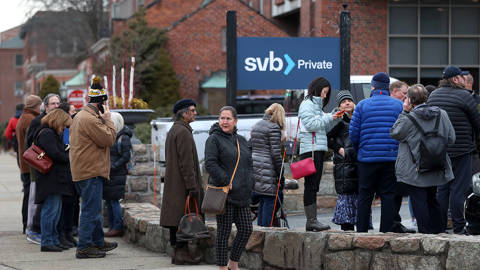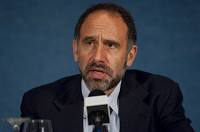There is a standard tale of politics where conservatives want to leave things to the market, whereas the left want a big role for government. The right likes to tell this story because it advantages them politically, since most people tend to have a positive view of the market. The left likes to tell it because they are not very good at politics and have an aversion to serious thinking.
The Silicon Valley Bank (SVB) bailout is yet another great example of how the right is just fine with government intervention, as long as the purpose is making the rich richer. Left to the market, the outcome in this case was clear. The FDIC guaranteed accounts up to $250k. This meant that the government’s insurance program would ensure that everyone got the first $250,000 in their account returned in full.
The amounts above $250,000 were not insured. This is both a matter of law and a matter of paying for what you get. The FDIC chargesa fee on the first $250,000 in an account based on the size and strength of the bank. This fee ranges from 0.015 percent to 0.40 percent annually, depending on the size and riskiness of the bank. Most people would not see the insurance fee directly, because it is charged to bank, but we can be sure that the bank passes this cost on to its depositors.
However, these fees only apply to the first $250,000 in an account. This means that people who had more than $250,000 in an account were not paying for insurance. Nonetheless, when they needed insurance from the government, they got it, even though they didn’t pay for it.
As we are now hearing, in many cases this handout ran into the tens of millions, or even billions, of dollars, almost all of it going to the very richest people in the country. Compare these depositors’ sense of entitlement to a government handout, to the outrage over President Biden’s proposal to forgive $10,000 of student loan debt. (To be clear, depositors likely would have gotten 80 to 90 percent of their money back in any case.)
In the case of SVB, rich depositors could not bother themselves with taking steps to ensure that their money was parked in a safe place. This is in spite of the fact that almost all of them pay people to help them manage their money.
By contrast, in the case of student loan debt, many 18-year-olds may have misjudged their future labor market prospects. This sort of error would not be surprising given the economic turmoil we have seen since the collapse of the housing bubble and the Great Recession.
Making the Rich Richer with Drugs and Vaccines
The idea that the purpose of government is to make the rich richer pervades every aspect of economic policy. When we were confronted with a worldwide pandemic, the government spent billions of dollars to quickly develop effective vaccines and treatments. And then, after developing them, we gave private companies like Moderna intellectual property rights over the product.
Naturally, this sent Moderna’s stock soaring and made at least fiveModerna executives into billionaires. Only children and elite intellectuals could think the extreme inequality we see in this story has anything to do with the market, but we will get the same tale again and again. The right wants to accept market outcomes, while the left wants to use the government to address inequality.
It’s striking that even now the government is acting to make the Moderna crew still richer. Moderna and Pfizer have announced that they want to charge between $110 and $130 a shot for their new Covid booster.
Peter Hotez and Elena Bottazzi, two highly respected researchers at Baylor University and Texas Children’s Hospital, developeda simple to produce, 100 percent open-source Covid vaccine. It uses well-established technologies that are not complicated (unlike mRNA). Their vaccine has been widely used in India and Indonesia, with over 100 million people getting the vaccine to date.
If we want to see the vaccine used here it would need to be approved by the Food and Drug Administration (FDA). In principle, the FDA could rely on the clinical trials used to gain approval in India, but it indicated that they want a U.S. trial. (In fairness, India’s trials are probably lower quality.)
However, the government could fund a trial of Hotez-Bottazzi vaccine (Corbevax) with pots of money left over from Operation Warp Speed, or alternatively from the budgets of National Institutes of Health or other agencies like Biomedical Advanced Research and Development Authority (BARDA). With tens of billions of dollars of government money going to support biomedical research each year, the ten million or so needed for a clinical trial of Corbevax would be a drop in the bucket.
The arithmetic on this is incredible. Shots of Corbevax cost less than $2 a piece in India. If it costs two and a half times as much in the U.S., that still puts it at $5 a shot. That implies savings of more than $100 a shot.
That means that if we get 100,000 people to take the Corbevax booster, rather than the Modern-Pfizer ones (Pfizer is planning to also charge over $100 for its booster), we’ve covered the cost of the trials. If we get 1 million to take Corbevax, we’ve covered the cost ten times over, and if 10 million people get the Corbevax booster, we will have saved one hundred times the cost of the clinical trial.
But for now, we are not going this route. Remember, the purpose of government is to make the rich richer.
This is a huge story in the pharmaceutical industry more generally. We will spend close to $550 billion this year on prescription drugs. These drugs would almost certainly cost less than $100 billion a year if they were sold in a free market without government-granted patent monopolies or related protections.
The differences of $450 billion is roughly half the size of the military budget and more than four times what we will spend on the Food Stamp program. It comes to more than $3,000 per household each year, and yes, it mostly goes to people at the top end of the income distribution.
We would have to replace the roughly $100 billion a year that the industry spends on research, but we would almost certainly come out way ahead in that story, as with the Hotez-Bottazzi vaccine.
In addition, by making drugs cheap, we will end the crisis that many people face in trying to come up with the money to pay for life-saving drugs. We would also eliminate the enormous incentive that patent-protected drug prices give drug companies to lie about the safety and effectiveness of their drugs.
Structuring Finance to Serve the Market, not the Rich
We don’t need to have a financial system that has periodic bank collapses and makes millionaires and billionaires out of top bank executives. This is a policy choice by a government committed to making the rich richer.
The most obvious solution would be to have the Federal Reserve Board give every person and corporation in the country a digital bank account. The idea is that this would be a largely costless way for people to carry on their normal transactions. They could have their paychecks deposited there every two weeks or month. They could have their mortgage or rent, electric bill, credit card bill, and other bills paid directly from their accounts.
This sort of system could be operated at minimal cost, with the overwhelming majority of transactions handled electronically, requiring no human intervention. There could be modest charge for overdrafts, that would be structured to cover the cost of actually dealing with the problem, not gouging people to make big profits.
Former Fed economist (now at Dartmouth), Andy Levin, has been etching the outlines of this sort of system for a number of years. The idea would be to effectively separate out the banking system we use for carrying on transactions from the system we use for saving and financing investment.
We would have the Fed run system to carry out the vast majority of normal financial transactions, replacing the banks that we use now. However, we would continue to have investment banks, like Goldman Sachs and Morgan Stanley, that would borrow on financial markets and lend money to businesses, as well as underwriting stock and bond issues. While investment banks still require regulation to prevent abuses, we don’t have to worry about their failure shutting down the financial system.
Not only would the shift to Fed banking radically reduce the risk the financial sector poses to the economy, it would also make it hugely more efficient. We waste tens of billions of dollars every year maintaining the structure of a financial system that technology has made obsolete.
The current system also makes some people incredibly rich, even when they fail disastrously. Greg Becker, the President and Chief Executive Officer, earned$9,922,000 in SVB’s 2021 fiscal year (the most recent year for which I could find the data). That would be roughly 684 times what a minimum wage worker would earn for a full year’s work. (Top execs at the largest banks can earn three or four times this amount.)
If we think that a worker has a 45-year working lifetime, then Mr. Becker pulls down more in a year than what a minimum wage worker would get in 15 working lifetimes. The CEOs at Lehman and Bear Stearns, two of the huge failed banks in the financial crisis, walked away with hundreds of millions of dollars for their work.
So, the basic story is that the government has designed a financial system designed to redistribute massive amounts of money to the rich. We could have a hugely more efficient system, but since that would end the gravy train for those at the top, it is not on the political agenda.
The Big Lie: Conservatives Don’t Like Big Government
As this bailout should make clear is that, contrary to what the media tell us, conservatives love big government. They just think that the focus of big government should be making the rich as rich as possible, not helping ordinary people and securing the economy and society.
To be clear, I do think this bailout was necessary given the fragility of the economy at present (unlike the 2008-09 bailout, that was sold with the lie that we faced a Second Great Depression). However, we need to get our eye on the ball here.
The idea that conservatives like the market and not the government is unadulterated crap. It is a myth that they use to conceal the ways they have rigged the market to make income flow upward. Unfortunately, virtually the entire left has agreed to go along with this absurd myth. Moments like the bailout of the rich depositors at SVB make the truth about conservatives and the market apparent to all. (And yes, this is the point of Rigged [it’s free].)






